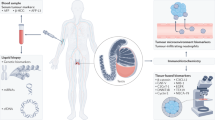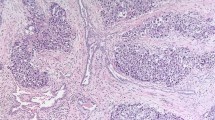Abstract
Serum tumor markers play a critical role in the diagnosis, staging, risk stratification, and surveillance of patients with testicular germ cell tumors (GCTs). Production of the oncofetal substances α fetoprotein and human chorionic gonadotropin can aid the diagnosis of testicular GCTs, and specific patterns of marker elevation can be used to determine the type of tumor, particularly as it pertains to nonseminoma. These markers, in addition to lactate dehydrogenase, have been incorporated in the standard TNM staging system for testicular tumors; the S stage category corresponds to serum elevation of these proteins. Furthermore, the degree of serum tumor marker elevation has been incorporated into standardized patient risk groupings, which are used to guide therapeutic management. The rate of tumor marker decay after radical orchiectomy is an important index to monitor, as a slow decline might be indicative of metastatic disease and should prompt a thorough systemic survey. The rate of tumor marker decline is already being utilized in the setting of metastatic GCTs to determine response to chemotherapy, and has been used in some scenarios to individualize the type of chemotherapy patients received. Compared to any other solid organ malignancy, the role of serum tumor markers in GCT is unprecedented; these markers are instrumental in the diagnosis and management of testicular GCT.
Key Points
-
The prognostic utility of serum tumor markers is reflected in the inclusion of a category in the standard TNM staging system to account for elevation of three such markers: α fetoprotein, human chorionic gonadotropin, and lactate dehydrogenase
-
At least one serum tumor marker is elevated in 85% of nonseminomatous germ cell tumors, and a significant number of seminomas and nonseminomas are associated with elevated markers before radiographic or clinical manifestations of disease
-
The differential diagnosis for elevated serum tumor markers includes neoplastic, infectious, metabolic, toxic and genetic etiologies
-
Initial evaluation of patients with elevated serum tumor markers should include a complete history and physical examination, scrotal ultrasonography, chest radiography, and blood tests including liver function tests, complete blood count, and a metabolic panel
-
The rate of serum tumor marker decline after orchiectomy or after treatment for metastatic nonseminoma has prognostic significance and should be considered in management algorithms
-
In general, the schedule for surveillance after radical orchiectomy includes monthly measurements of serum tumor markers for the first year after treatment with gradually widening surveillance intervals until the sixth year of recurrence-free status when annual measurement can commence
This is a preview of subscription content, access via your institution
Access options
Subscribe to this journal
Receive 12 print issues and online access
$209.00 per year
only $17.42 per issue
Buy this article
- Purchase on Springer Link
- Instant access to full article PDF
Prices may be subject to local taxes which are calculated during checkout
Similar content being viewed by others
References
Edge, S. B. et al. (Eds) AJCC Cancer Staging Manual (Springer-Verlag, New York, 2009).
Mostofi, F. K., Sesterhenn, I. A. & Sobin, L. H. in World Health Organization: International Histological Typing of Tumors, 2nd edn, 1–132 (Springer-Verlag, Berlin, 1998).
Javadpour, N. The role of biologic tumor markers in testicular cancer. Cancer 45, 1755–1761 (1980).
Bagshawe, K. & Searle, F. in Essays in Medical Biochemistry, Vol. 3 (eds Marks, C. & Hales, C.) 25–74 (Biochemical Society, London, 1977).
Perkins, G. L., Slater, E. D., Sanders, G. K. & Prichard, J. G. Serum tumor markers. Am. Fam. Physician 68, 1075–1082 (2003).
Uriel, J. Retrodifferentiation and the fetal patterns of gene expression in cancer. Adv. Cancer Res. 29, 127–174 (1979).
Abelev, G. I. Alpha-fetoprotein as a marker of embryo-specific differentiations in normal and tumor tissues. Transplant Rev. 20, 3–37 (1974).
Bergstrand, C. G. & Czar, B. Demonstration of a new protein fraction in serum from the human fetus. Scand. J. Clin. Lab. Invest. 8, 174 (1956).
Richie, J. & Steele, G. in Campbell-Walsh Urology (eds Wein, A. J., Kavoussi, L. R., Novick, A. C., Partin, A. W. & Peters, C. A.) 893–935 (Saunders, 2006).
Yuasa, T. et al. Detection of alpha-fetoprotein mRNA in seminoma. J. Androl. 20, 336–340 (1999).
Zondek, B. Versuch einer biologischen (Hormonalen) diagnostik beim malignen hodentumor [German]. Chirug 1930 2, 1072–1080 (1930).
Wehmann, R. E. & Nisula, B. C. Metabolic and renal clearance rates of purified human chorionic gonadotropin. J. Clin. Invest. 68, 184–194 (1981).
Weissbach, L. et al. Prognostic factors in seminomas with special respect to HCG: results of a prospective multicenter study. Seminoma Study Group. Eur. Urol. 36, 601–608 (1999).
Boyle, L. & Samuels, M. Serum LDH activity and isoenzyme patterns in nonseminomatous germinal (NSG) testis tumors [abstract C-48]. Proc. Am. Soc. Clin. Oncol. 18, 278 (1977).
Skinner, D. G. & Scardino, P. T. Relevance of biochemical tumor markers and lymphadenectomy in management of nonseminomatous testis tumors: current perspective. J. Urol. 123, 378–382 (1980).
Stanton, G. et al. Treatment of patients with advanced seminoma with cyclophosphamide, bleomycin, actinomycin D, vinblastine and cisplatin [abstract]. Proc. Am. Soc. Clin. Oncol. 2, 1 (1983).
Javadpour, N. Multiple biochemical tumor markers in seminoma. A double-blind study. Cancer 52, 887–889 (1983).
Nielsen, O. S. et al. Is placental alkaline phosphatase (PLAP) a useful marker for seminoma? Eur. J. Cancer 26, 1049–1054 (1990).
Barlow, L. J., Poon, S. A. & McKiernan, J. M. The case of a poorly differentiated gastric adenocarcinoma disguised as a testicular germ cell tumor in a 34-year-old male. Urology 74, 722–725 (2009).
Chun, H. H. & Gatti, R. A. Ataxia-telangiectasia, an evolving phenotype. DNA Repair (Amst.) 3, 1187–1196 (2004).
Scott, C. R. The genetic tyrosinemias. Am. J. Med. Genet. C Semin. Med. Genet. 142C, 121–126 (2006).
McVey, J. H. et al. A G–>A substitution in an HNF I binding site in the human alpha-fetoprotein gene is associated with hereditary persistence of alpha-fetoprotein (HPAFP). Hum. Mol. Genet. 2, 379–384 (1993).
Fowler, J. E. Jr, Platoff, G. E., Kubrock, C. A. & Stutzman, R. E. Commercial radioimmunoassay for beta subunit of human chorionic gonadotropin: falsely positive determinations due to elevated serum luteinizing hormone. Cancer 49, 136–139 (1982).
Thompson Coon, J. et al. Surveillance of cirrhosis for hepatocellular carcinoma: systematic review and economic analysis. Health Technol. Assess. 11, 1–206 (2007).
Di Bisceglie, A. M. et al. Serum alpha-fetoprotein levels in patients with advanced hepatitis C: results from the HALT-C Trial. J. Hepatol. 43, 434–441 (2005).
Chen, D. S. et al. Serum alpha-fetoprotein in the early stage of human hepatocellular carcinoma. Gastroenterology 86, 1404–1409 (1984).
Ho, D. M., Hsu, C. Y., Ting, L. T. & Chiang, H. The clinicopathological characteristics of gonadotroph cell adenoma: a study of 118 cases. Hum. Pathol. 28, 905–911 (1997).
Ohdaira, H., Murai, R., Hanyu, N., Abe, M. & Yanaga, K. Gastric cancer producing AFP/HCG which had a rapidly progressive course with metastasis to the brain discovered postoperatively [Japanese]. Nippon Shokakibyo Gakkai Zasshi 104, 666–670 (2007).
Erhan, Y., Ozdemir, N., Zekioglu, O., Nart, D. & Ciris, M. Breast carcinomas with choriocarcinomatous features: case reports and review of the literature. Breast J. 8, 244–248 (2002).
Tsurumachi, T. et al. Resection of liver metastasis from alpha-fetoprotein-producing early gastric cancer: report of a case. Surg. Today 27, 563–566 (1997).
Bosl, G. J. & Motzer, R. J. Testicular germ-cell cancer. N. Engl. J. Med. 337, 242–253 (1997).
International Germ Cell Consensus Classification: a prognostic factor-based staging system for metastatic germ cell cancers. International Germ Cell Cancer Collaborative Group. J. Clin. Oncol. 15, 594–603 (1997).
Lange, P. & Raghavan, D. in Testis Tumor (ed. Donohue, J.) 111–130 (Williams & Wilkins, Baltimore, 1983).
Mazumdar, M. et al. Predicting outcome to chemotherapy in patients with germ cell tumors: the value of the rate of decline of human chorionic gonadotrophin and alpha-fetoprotein during therapy. J. Clin. Oncol. 19, 2534–2541 (2001).
Fizazi, K. et al. Early predicted time to normalization of tumor markers predicts outcome in poor-prognosis nonseminomatous germ cell tumors. J. Clin. Oncol. 22, 3868–3876 (2004).
Mego, M. et al. Kinetics of tumor marker decline as an independent prognostic factor in patients with relapsed metastatic germ-cell tumors. Neoplasma 56, 398–403 (2009).
Motzer, R. J. et al. Phase III randomized trial of conventional-dose chemotherapy with or without high-dose chemotherapy and autologous hematopoietic stem-cell rescue as first-line treatment for patients with poor-prognosis metastatic germ cell tumors. J. Clin. Oncol. 25, 247–256 (2007).
Olofsson, S. et al. Individualized intensification of treatment based on tumor marker decline in metastatic nonseminomatous germ cell testicular cancer (NSGCT): A report from the Swedish Norwegian Testicular Cancer Group, SWENOTECA. Presented at the 45th Annual Meeting of the American Society of Clinical Oncology.
George, D. W. et al. Update on late relapse of germ cell tumor: a clinical and molecular analysis. J. Clin. Oncol. 21, 113–122 (2003).
Eastham, J. A., Wilson, T. G., Russell, C., Ahlering, T. E. & Skinner, D. G. Surgical resection in patients with nonseminomatous germ cell tumor who fail to normalize serum tumor markers after chemotherapy. Urology 43, 74–80 (1994).
Murphy, B. R. et al. Surgical salvage of chemorefractory germ cell tumors. J. Clin. Oncol. 11, 324–329 (1993).
Ackers, C. & Rustin, G. J. Lactate dehydrogenase is not a useful marker for relapse in patients on surveillance for stage I germ cell tumours. Br. J. Cancer 94, 1231–1232 (2006).
Bartlett, N. L., Freiha, F. S. & Torti, F. M. Serum markers in germ cell neoplasms. Hematol. Oncol. Clin. North Am. 5, 1245–1260 (1991).
Kondagunta, G. V., Sheinfeld, J. & Motzer, R. J. Recommendations of follow-up after treatment of germ cell tumors. Semin. Oncol. 30, 382–389 (2003).
Acknowledgements
C. P. Vega, University of California, Irvine, CA, is the author of and is solely responsible for the content of the learning objectives, questions and answers of the MedscapeCME-accredited continuing medical education activity associated with this article.
Author information
Authors and Affiliations
Contributions
L. J. Barlow, G. M. Badalato and J. M. McKiernan contributed equally to the researching, discussion, writing and reviewing of the manuscript.
Corresponding author
Ethics declarations
Competing interests
The authors declare no competing financial interests.
Rights and permissions
About this article
Cite this article
Barlow, L., Badalato, G. & McKiernan, J. Serum tumor markers in the evaluation of male germ cell tumors. Nat Rev Urol 7, 610–617 (2010). https://doi.org/10.1038/nrurol.2010.166
Published:
Issue Date:
DOI: https://doi.org/10.1038/nrurol.2010.166
This article is cited by
-
The Road Ahead for Circulating microRNAs in Diagnosis and Management of Testicular Germ Cell Tumors
Molecular Diagnosis & Therapy (2021)
-
Testicular germ cell tumor: a comprehensive review
Cellular and Molecular Life Sciences (2019)
-
Tumor markers: myths and facts unfolded
Abdominal Radiology (2019)
-
Diagnostic and prognostic value of 18F-FDG PET/CT in recurrent germinal tumor carcinoma
European Journal of Nuclear Medicine and Molecular Imaging (2018)
-
Differential expression of miRNAs in the seminal plasma and serum of testicular cancer patients
Endocrine (2017)



